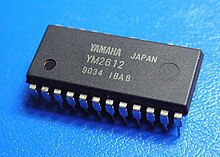Yamaha YM2612
hideThis article has multiple issues. Please help or discuss these issues on the talk page. (Learn how and when to remove these template messages)
|

The YM2612, a.k.a. OPN2, is a sound chip developed by Yamaha. It belongs to Yamaha's OPN family of FM synthesis chips used in several game and computer systems.
Overview[]
The Yamaha YM2612 is a six-channel FM synthesizer, derived from the Yamaha YM2203c.[1] It was most notably used in Sega's Mega Drive/Genesis video game console,[2] as well as Fujitsu's FM Towns computer series.[3] As with the YM3438, it was used by Sega in various arcade game systems, including the Mega-Play and Sega System 32.
Features[]
The YM2612 has the following features:[1]
- Six FM channels
- Four operators per channel[4]
- Two interval timers
- A sine-wave low frequency oscillator
- Integrated stereo output digital-to-analog converter (most other contemporary Yamaha FM chips require a separate external D/A converter chip)
- Per-channel programmable stereo sound (left, right, or both left and right resulting in centre)
- For channel three, operator frequencies can be set independently, making dissonant harmonics possible. (Normally, they would have a simple relation like e.g. 2× or 3× relative to a common base frequency)
Technical details[]
The YM2612's FM synthesis block is an extended version of the FM block featured in the YM2203, adding two channels and integrating a stereo output DAC.[1] The YM2612 removes the SSG component and I/O ports found in the YM2203, YM2608 and YM2610.[1] It was also available in CMOS form, as the YM3438, a.k.a. OPN2C.[1]
Whereas the high-end OPN chips such as the YM2608B have dedicated ADPCM channels for playing sampled audio, the YM2612 does not. However, its sixth channel can act as a basic PCM channel by means of the 'DAC Enable' register, disabling FM output for that channel but allowing it to play 8-bit pulse-code modulation sound samples (in practice 7 bit because the MSB enables the DAC if set).[1] Unlike the other OPNs with ADPCM, the YM2612 does not provide any timing or buffering of samples, so all frequency control and buffering must be done in software by the host processor.[2]
Output DAC peculiarities[]
Unlike most Yamaha FM chips which require an external floating-point DAC, the YM2612 features a built-in 9-bit DAC, which utilizes time-division multiplexing to play one sample of each channel in sequence, similar to the YM2413.[citation needed] Due to an error in the amplitude voltage, a peculiar form of crossover distortion is introduced in the output.
Additionally, because of the reduced dynamic range of the built-in DAC, additional distortion may be generated when playing sounds with a very high volume.[1]
Variants[]
Yamaha YM3438[]
The YM3438,[1] a.k.a. OPN2C, is a modified CMOS version of the YM2612. It is not a direct, drop-in replacement for the YM2612 however, as the sound outputs have higher impedance.
Yamaha YMF276[]
The YMF276, a.k.a. OPN2L, is a low-power version of the YM3438. Unlike YM2612 and YM3438, the YMF276 requires external DAC.
Sega Mega Drive ASICs made by Yamaha (FC1004, FF1004, FJ3002 and FQ8007)[]
The YM3438 core was integrated in custom ASICs[5] used in most revisions of the Model 2 version of the Sega Mega Drive/Genesis.
Game audio[]
Paired with the Texas Instruments SN76489 square wave/noise generator as the main sound generator of the Sega Mega Drive/Genesis console, the YM2612 was prominently utilized by numerous prolific video game music composers, such as Yuzo Koshiro.[4][6]
Other uses[]
In 2020, the company Twisted Electrons released the MEGAfm, a desktop synthesizer module that uses two YM2612 chips.[7]
A VST, AU and AAX and Reason Studios Rack Extension plugin called YM2612 was made by Inphonik. This includes cycle accurate envelopes and quirks of the original chip. [8] They also offer a free sample and bitrate reduction plugin, the PCM2612, that emulates the timbre of the original chip playing a sample through the DAC channel. [9]
See also[]
- VGM – an audio file format for multiple video game platforms, including the Sega Mega Drive/Genesis
- Yamaha YM2203
- Yamaha YM2608
- Yamaha YM2612
References[]
- ^ Jump up to: a b c d e f g h YM3438 Application Manual (Japanese)
- ^ Jump up to: a b Sega Genesis Technical Manual - YM2612 section (updated with errors corrected)
- ^ Purcaru, Bogdan Ion (13 March 2014). Games vs. Hardware. The History of PC video games: The 80's. p. 527. Retrieved 14 December 2017.
- ^ Jump up to: a b "Super Sonic: Creating the new sound of Sega's hedgehog hit". 13 February 2020.
- ^ https://console5.com/techwiki/images/5/57/Sega_Service_Manual_-_Genesis_II_-_Mega_Drive_II_%28PAL-B-I-G%2C_RGB%29%2C_No_001%2C_June%2C_1993.pdf
- ^ "Sega Mega Drive Mini review – a legacy truly honoured". 19 September 2019.
- ^ "MEGAfm".
- ^ https://www.inphonik.com/products/rym2612-iconic-fm-synthesizer/. Missing or empty
|title=(help) - ^ https://www.inphonik.com/products/pcm2612-retro-decimator-unit/. Missing or empty
|title=(help)
External links[]
- Yamaha sound chips
- Video game music technology